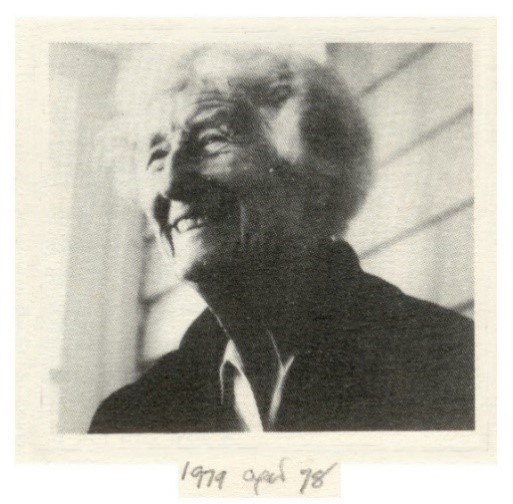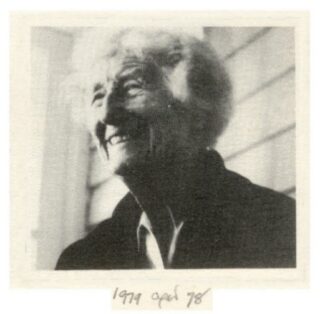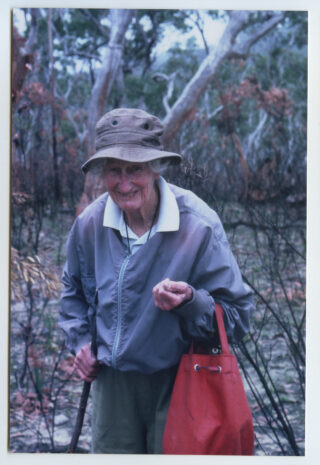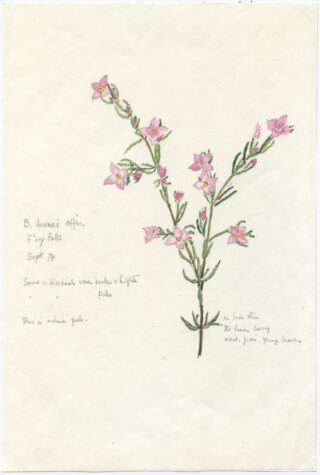- Entry type: Person
- Entry ID: AWE6612
Cosh, Janet Louise
(1901 – 1989)
- Born 21 April 1901, Ashfield, New South Wales, Australia
- Died 22 October 1989, Moss Vale, New South Wales, Australia
- Occupation Amateur botantist, Botanical collector, Teacher
Summary
Janet Cosh was the only child of Dr John and Louise Cosh (née Calvert). Janet attended the University of Sydney, where she studied English, History and the Classics. She moved to the Southern Highlands in 1934, where she took a keen interest in local history and the natural environment. In her late sixties, Janet devoted her life to the study of the native flora of the Southern Highlands, New South Wales and became a highly respected amateur botanist. After Janet’s death, her bequest to the University of Wollongong provided funds and botanical resources which were used to establish the Janet Cosh Herbarium.
Details
Janet Cosh was born in Sydney in 1901, the only child of Dr John and Louise Cosh (née Calvert). Janet was an educated woman who attended Sydney University where she studied English, History and the Classics. From 1923 to 1926 she taught Latin and English at her former school, Normanhurst Girls School. Her passion for natural history and botany was inspired by her parents and also her grandparents. In particular, her maternal grandmother Louisa Atkinson was a botanist, natural historian and writer who collected for the notable botanists Rev. Dr. William Woolls and Sir Ferdinand von Mueller. Janet’s great grandmother, Charlotte Barton, raised four children under very tragic circumstances but still managed to write the first children’s book to be published in Australia, A Mother’s Offering to Her Children (1841), which mentions native flora and fauna and was an early example of Australian themes and experiences including colonisation and its effect on Aboriginal people.
In 1934, Janet moved to the Southern Highlands, New South Wales with her parents after her father retired from his medical practice in Sydney. They purchased ‘Netherby’ in Moss Vale where Janet lived for the rest of her life and was a member of the All Saint’s Church at Sutton Forest. She was a dutiful daughter and cared for her parents until they died, her father in 1946 and mother in 1956. By then in her fifties, this quiet reserved woman was able to devote her time and passion to a systematic study of the history of the Southern Highlands and later botany. In both of these areas of interest she left permanent and accurate records. Janet is mentioned in the Australian Geographic (2019) as an ‘incredible Australian woman in botany’.
Janet collected cuttings from local newspapers and The Sydney Morning Herald, especially about local history and conservation. She was a member of the National Trust and founding member of the Berrima District Historical Society in 1960. The Royal Australian Historical Society encouraged and supported local societies by teaching research and cataloguing skills. From 1964 to 1977, Janet was the local society’s archivist.
In the late 1960s, Janet concentrated her attention to the study of botany and collected numerous plant specimens to add to her knowledge. She made significant contributions to plant taxonomy, providing a rigorous basis for understanding the ecology and biodiversity of the native flora in the Southern Highlands of New South Wales. Janet was a frequent visitor to the Fitzroy Falls Visitors Centre, Morton National Park, where she stored her specimens. It was here, in the 1970s, that she met and befriended Pat Hall, Special Duties Officer at the time and later Manager of Education, Information & Tourism at the Centre. In turn, Pat introduced Janet to local people with an interest in botany. Funds from the National Park Foundation were used to establish the Janet Cosh Room at the Fitzroy Falls Visitors Centre in March 2000 as an education resource for the community.
Don Tilley was a ranger and he met Janet when he caught this old woman picking plants illegally on Water Board land until she produced her NSW National Parks & Wildlife scientific licence which made them both chuckle. They became friends with a shared interest in the native flora. Don recollected that Janet had an impact and influence on everyone she met and most especially on him, ‘She was that particular about identification and was able to name even the smallest plant’ except in 1982 Don collected an unusual Hibbertia which Janet and others after her could not identify. In 2001, Belinda Pellow collected another sample and sent it to an expert in South Australia. Toelken, H.R. (2012) identified and published it as Hibbertia accaulothrix in the Journal of the Adelaide Botanic Gardens.
As an amateur botanist, Janet was highly respected and was often in consultation with professional organisations such NSW National Parks & Wildlife Service and taxonomists at the National Herbarium of NSW, the Australian National Herbarium and the Commonwealth Scientific and Industrial Research Organisation. Insights are provided into Janet’s keen intellect by the many examples of letters exchanged with these authorities from prominent personnel such as L.A.S. Johnson, J. Armstrong, J.D. Briggs and D.A. Johnstone, which are wonderful examples of the polite and lengthy communications by mail in the 1970s. However, Janet was not averse to challenging senior botanists about their plant identifications and was quite disdainful about the use of common names. A number of the letters from the National Herbarium of NSW are acknowledgement of donations Janet made over the years. Significantly, Janet was the first donor to the National Herbarium of NSW Research Fund in response to a request in the journal Telopea in 1973. Over thirty specimens that Janet collected were considered to be worthy of incorporation into the National Herbarium of NSW. Some were significant species, for example, threatened Grevillea rivularis collected at Carrington Falls in 1976 and rare Zieria murphyii collected at View Point, Bundanoon in 1973.
Janet’s botanical fieldwork was thorough and methodical and her field notes were precise. She was extremely proficient at map reading, having been recruited during World War II to locate and map various routes from the coast across the Southern Highlands to the inland. She was also interested in the accounts written by early travellers and explorers and perused old maps and acquired extensive knowledge about the geography of the Southern Highlands.
Specimen locations were always recorded clearly and accurately. Range extensions of several species were documented by Janet as well as new locations for rare species such as Phyllota humifusa, Hakea constablei and Acacia chalkeri. Each specimen was identified by Janet using various systematic keys such as the Flora of the Sydney Region and by consulting with the National Herbarium of NSW. Janet amassed a collection of botanical books and maps, which she annotated prolifically and succinctly.
Janet shared a keen interest in the ecology of plants with her friends Ros Badgery and Rachel Roxburgh, both resilient women. They all enjoyed exploring the bush and studying the native flora and fauna. They were also concerned about the conservation of the natural environment. Ros and Janet became friends in 1963 after the death of Dorothy Farran, a mutual acquaintance who was in their congregation. Ros was given Dorothy’s copy of ‘Moore & Betche’ published in 1893, the first official botanical flora. Janet was given some other botanical books. Janet asked Ros for help with botany but Ros said later that, ‘With her brain she outstripped me in no time’. After her family died, Ros managed a 2000 acre property in the Southern Highlands on her own for 65 years. Most of the property was declared a Wildlife Refuge in 1968, which would have pleased Janet immensely. Rachel and Janet probably met as members of the National Trust, the Berrima Historical Society and the National Parks Association in the 1960s when they became aware of their mutual interests. Rachel was a woman of strong convictions, rarely given to compromise and was described as ‘patrician in bearing and manner’. She was undaunted by politicians, municipal officers and bureaucrats. But from all accounts she was in awe of Janet Cosh and Janet was never daunted by her brusque manner towards others. They had some great adventures together while they were out collecting. On one occasion, they went to investigate the flora of Rodway Nature Reserve, an open forested plateau with steep cliffs near Berry off the end of Drawing Room Rocks. They couldn’t negotiate their way back in the dark so they spent the night there with a camp fire to keep warm, much to the consternation of the local constabulary!
Rachel wished to study subjects in ecology at the University of Wollongong and was rather upset when informed she had to pay student fees for services she would never use except the library. Dr Rob Whelan, lecturer in biology, found a solution by allowing her to attend lectures and complete assignments in 1982 without being enrolled. Kevin Mills was a PhD student at the University of Wollongong studying the Illawarra rainforests in the 1980s when he met Janet and Rachel in the Southern Highlands. Between these friends and their association with Dr Rob Whelan they developed a keen interest to establish a regional herbarium in the Illawarra. It is very likely these connections informed Janet’s decision to include the University of Wollongong in her will.
Janet made bequests to various organisations including The Royal Historical Society; All Saints Church of England, Sutton Forest; NSW Parks & Wildlife Foundation; Sydney City Mission; National Herbarium of NSW, Royal Botanic Gardens, Sydney and the University of Wollongong. The bequest to the University of Wollongong, which included substantial funds and botanical resources, was ‘to be used for the herbarium or botanical research’ in accordance with her last will and testament. Dr Rob Whelan (later Emeritus Professor, University of Wollongong) ensured that the specifics of Janet’s bequest were adhered to. As of 2019, the integrity of Janet’s bequest has been upheld.
The Janet Cosh Herbarium was established in 1991. Janet’s botanical resources included a collection of over 1600 specimens, about 1500 botanical illustrations, a library, numerous field notebooks, photographs, vegetation surveys and maps. At the time, this also allowed Dr Kevin Mills’ research specimen collection to be incorporated into the Janet Cosh Herbarium. Janet’s collection included excellent examples of recycling using envelopes, notepaper, cardboard packaging, old Christmas cards and even the reverse side of her father’s watercolour paintings to record notes, drawings and mount specimens. Apparently, Janet was quite dismissive about her father’s numerous watercolours. They were later assessed by an expert and deemed to have no artistic value. Belinda Pellow, an expert botanist, was the first curator of the Janet Cosh Herbarium and responsible for developing a herbarium from Janet’s bequest. Belinda was one of the authors of the 5th Edition of Flora of the Sydney Region (2009). It is worth noting that Janet used the first edition, which she split in half for ease of carrying in the field.
The purpose of a herbarium is to store a collection of dried, preserved and catalogued plant specimens for identification and reference purposes whereby each specimen verifies the existence of an individual plant at a particular place and time. The Janet Cosh Herbarium facilitates botanical research, teaching, expertise in plant identification and the management of native vegetation in a regional context. Janet’s botanical illustrations and plant specimens provide meticulous details of plants and their environment. The data she systematically recorded in the field are still being used as a taxonomical reference to assist with plant identification. Over the years, the collection has continued to grow with contributions from local botanists, researchers, students and the community. As at 2019, the Janet Cosh Herbarium holds almost 12,000 specimens and facilitates the teaching of undergraduate students, provides support for post-graduate students and research staff and has inter-departmental links, for example with the Faculty of Creative Arts to curate exhibitions of Janet’s botanical illustrations and other projects and the Faculty Management Division to establish Campus Tree Walks for social and educational purposes.
Janet’s bequest to the Royal Botanic Gardens, Sydney was for the purpose of contributing to the National Herbarium of NSW. According to Barbara Briggs, one of the foremost Australian botanists and from what was known of Janet’s interests and intentions, this was interpreted as support for any aspect of systematic research, collection management and public information about scientific programs. Various projects have been implemented including an inaugural studentship in 2001 to contribute to research in plant taxonomy or to encourage young scientists to consider a career in plant taxonomy or ecology. This bequest also enabled the Scientific Division to be more active and entrepreneurial than would otherwise have been possible. Activities associated with Janet Cosh’s bequest are documented and acknowledged in various Annual Reports and publications such as the journals Telopea and Australian Systematic Botany.
Janet was highly respected for her botanical knowledge and was an inspiration to all who knew her. She made many significant contributions to plant ecology in the Illawarra and Southern Highlands which may be summarised as follows:
- collected over 1600 plant specimens and prepared over 1500 annotated illustrations which formed the foundation of the Janet Cosh Herbarium
- prepared a herbarium of 1500 specimens for Fitzroy Falls Visitors Centre, Morton National Park
- contributed to the knowledge of the National Herbarium of NSW
- recorded meticulous field notes
- discovered range extension of several plant species and discovered new locations of rare plants
- collaborated with professional botanists
- contributed to the establishment of several nature reserves including Robertson Nature Reserve, Stingray Swamp and Cecil Hoskins Reserve
- prepared vegetation maps for Morton National Park
- compiled many species lists which have been included in natural history booklets, for example Eastern Rim Wildflower Walk (1985) and publications relevant to the Southern Highlands, for example Fitzroy Falls and Beyond: A guide to Shoalhaven (1988).
In the months prior to her death, in October 1989, the elderly Janet and Rachel became concerned with the decimation of the South East Forests of NSW. Travelling in Janet’s Subaru Brumby ute with their swags in the back, they made several trips to the area to document the impact of forestry practices in that region. Janet was still collecting specimens just a few weeks before she died and was planning a collecting trip to Fitzroy Falls. In honour of Janet Cosh, Flowering Wonderfully, the Botanical Legacy of Janet Cosh was compiled in 2012.
Janet is one example of a large group of women of her era, with independent means and a keen interest in natural history, who have contributed to our knowledge of science in a quiet but significant way. In fact, she was an early exponent of ‘Citizen Science’. As her friend Rachel Roxburgh said in Janet’s obituary, ‘In the field of botany, the records Miss Janet Cosh left will enable students to know exactly when and where to find plant species and the University of Wollongong’s appreciation of her purpose would give Janet great pleasure’.
Jean Clarke, Fellow of the University of Wollongong, has spent many years since her retirement working as a volunteer in the Janet Cosh Herbarium and devoted much of her time curating and preserving the Janet Cosh historical collection. Most of this collection was transferred to the University of Wollongong Archives in 2018. Jean provides assistance to curate the collection in the archives. It includes rare books, journal articles, letters, newspaper cuttings, photographs, field notes, botanical illustrations and other material donated by Janet Cosh. This collection complements the Cosh extended family collections held in the Mitchell library, Sydney and the National library Canberra.
The plant specimen collection, including those collected by Janet Cosh, is stored in the Janet Cosh Herbarium, School of Earth, Atmospheric & Life Sciences, University of Wollongong and managed by Professor Kris French.
This entry was prepared by University of Wollongong Fellow Jean Clarke, Janet Cosh Herbarium.
Archival resources
- State Library of New South Wales
- Royal Australian Historical Society
- National Library of Australia, Pictures Collection
- National Library of Australia, Manuscript Collection


